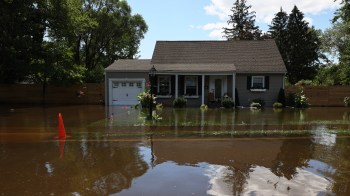Post-hurricane lessons from London
MARK AUSTIN THOMAS: It was a year ago today that Hurricane Katrina slammed into the Gulf coast states of Louisiana and Mississippi. The biggest impact was in Louisiana where 1,600 people died. In New Orleans only half the population has returned. Six city hospitals are still closed. Less than half of 128 public schools will open this fall.
President Bush is visiting the area today. He wants to highlight the efforts to rebuild but critics complain that things are moving too slowly. Katrina has pushed New Orleans into the ranks of other cities like Chicago, San Francisco and London that were forced to rebuild after a disaster.
John Steele Gordon is a business historian. He thinks the Gulf Coast region could learn a thing or two about rebuilding from 17th century London.
JOHN STEELE GORDON: You’ve got two ways to rebuild after a disaster: quick and dirty or slow and deliberate. They each have their advantages: quick and dirty gets the town back in business as soon as possible; slow and deliberate means focusing more attention on root causes and design.
Quick and dirty has its costs. Many people are moving back into neighborhoods in New Orleans that are dangerously vulnerable to flooding in the next hurricane — and there will be a next hurricane. When San Francisco was devastated by the 1906 earthquake, the hasty rebuilding left the city a new disaster waiting to happen, as the 1989 earthquake proved.
London is a good example of slow and deliberate. No, I don’t mean after the World War II blitz, I mean after the Great Fire of London in 1666, the greatest urban conflagration since Nero was playing his fiddle. The fire wiped out four-fifths of the heart of the city. It destroyed 13,000 buildings, 87 churches and the homes of 100,000 people.
Even the great medieval cathedral of St. Paul’s was a smoking ruin. Londoners estimated rebuilding at 10 million pounds. That doesn’t sound like much these days, but in the mid-17th century it was fully eight times the annual revenues of the king. There was no choice: rebuilding had to be slow and deliberate.
And frankly they did a pretty good job of it. The old London had been a medieval rabbit warren of wooden houses and narrow streets that fire could easily cross. The new London had wider streets and even some wide avenues that acted as firebreaks. The new housing stock erected over the next few years was made of brick, not wood.
The churches, one by one, were replaced by new ones, each a jewel of ecclesiastical architecture.
It was nine years before Sir Christopher Wren’s masterpiece, the new St. Paul’s, was designed and building started. It was 44r years after the fire that it was finally finished. But when it was, it was a wonder of the world and it still is, the proud symbol of one of the world’s great cities and the beating economic heart of all Europe.
Rebuilding can move a lot faster now then in the pre-industrial 17th century. But still, it’s a good idea, once confronted with the lemon of a great disaster, to take enough time to figure out the best way to make lemonade from it.
THOMAS: Business historian John Steele Gordon is author of “An Empire of Wealth.”
There’s a lot happening in the world. Through it all, Marketplace is here for you.
You rely on Marketplace to break down the world’s events and tell you how it affects you in a fact-based, approachable way. We rely on your financial support to keep making that possible.
Your donation today powers the independent journalism that you rely on. For just $5/month, you can help sustain Marketplace so we can keep reporting on the things that matter to you.


















